 few weeks after returning to Dayton, Wilbur wrote to
Octave Chanute and gave him a short but informative report on
what he and his brothers had accomplished in Kitty Hawk. Chanute was
impressed, not only with Wilbur’s short flights but also the
construction of his glider, the number and design of his scientific
experiments, and most especially that this young man had done it. He
had designed and built an aircraft, took it to a suitable
environment to test it safely, made a number of glides and recorded
the results. The scientific expedition itself was quite an
accomplishment; Chanute knew this to be true having done it himself
at the Indiana Dunes in 1896. The two chewed over the results of the
expedition for the remainder of 1900, Wilbur explaining his findings
and conclusions to Chanute and Chanute commenting, occasionally
offering an opinion.
few weeks after returning to Dayton, Wilbur wrote to
Octave Chanute and gave him a short but informative report on
what he and his brothers had accomplished in Kitty Hawk. Chanute was
impressed, not only with Wilbur’s short flights but also the
construction of his glider, the number and design of his scientific
experiments, and most especially that this young man had done it. He
had designed and built an aircraft, took it to a suitable
environment to test it safely, made a number of glides and recorded
the results. The scientific expedition itself was quite an
accomplishment; Chanute knew this to be true having done it himself
at the Indiana Dunes in 1896. The two chewed over the results of the
expedition for the remainder of 1900, Wilbur explaining his findings
and conclusions to Chanute and Chanute commenting, occasionally
offering an opinion.
Meanwhile, Wilbur and
Orville discussed among themselves the disappointing fact that the
1900 glider hadn’t produced the expected amount of lift and this had
kept Wilbur from making flights of any satisfying length or
duration. He certainly hadn’t accomplished his goal of flying for
hours, testing and refining his control system, and developing the
skills necessary to pilot an aircraft.
The brothers concluded
that either their glider hadn’t enough wing area to provide the
necessary lift or their use of a shallow camber – 1/23 compared to
the 1/12 that Lilienthal recommended – had somehow kept it from
developing proper lift. To insure success, they decided to build a
second glider with more wing area and a deeper camber.
Wilbur informed
Chanute in March 1901 of their plan to return to Kitty Hawk in to
test a new machine. That apparently started wheels turning in
Chanute’s head. It was time to meets these guys and take their
measure. He told Wilbur he was coming east and wanted to stop in
Dayton.
In early summer the
Wrights had a bit of unexpected luck. Saturday evening June 8,
Charlie Taylor stopped by the bicycle shop. Charlie was a good
friend and a fellow bicycle mechanic. He had married Henrietta
Webbert, whose father was a long-time friend of the Bishop. Her
uncle, Charles Webbert, owned the building that housed the Wright
Cycle Company. Charlie had been part owner of a machine tool
business that made coaster brake parts for the Wright’s line of
bicycles. Charlie also repaired bicycles and bought parts from the
Wrights. He had sold that business and used the money to buy a
house. Presently he was working for the Dayton Electric Company.
The Wrights’ bicycle
business was seasonal. In 1900, they had waited until autumn for it
to slow down before they left for Kitty Hawk. Then they had been
able to leave it in the hands of their brother Lorin and sister
Katharine. But Charlie knew the bicycle business. With him to mind
the store, they could leave anytime they wanted. They offered
Charlie $16.50 per week, considerably better than what he was
getting from his present employer. Charlie came to work for the
Wrights that next Monday. On June 19, Wilbur wrote Chanute, “ Owing
to changes in our business arrangements, we shall start our trip
much earlier than we expected…”
Chanute showed up on
the Wright’s doorstep a week later. He stayed for dinner and came
back the next day, spending the time deep in conversation with
Wilbur and Orville until he had to leave in the afternoon. It’s not
known what they discussed, but it’s more than probable the Wilbur
told him he was about to publish two articles on aeronautics –
“The
Angle of Incidence” in the Aeronautical Journal and “The
Horizontal Position During Gliding Flight” in Illustriete
Aeronautische Mitteilungen, a German publication. Chanute
probably mentioned the “gliding machine” that
Edward Huffaker was building for him and broached the subject of
testing it in Kitty Hawk.
Just a few days after
he returned to Chicago, Chanute wrote to Wilbur proposing that he
send Huffaker and another budding aeronautical engineer,
George Spratt to Kitty Hawk to help the Wright brothers. Wilbur
replied politely that he did not need the help, but that he and
Orville would be thankful for the company. They would provide a
place for Huffaker and Spratt to bunk should they want to visit. In
a quick exchange of letters, it was agreed that Huffaker, Spratt,
and Chanute would visit the Wrights at the Outerbanks. Chanute also
loaned the Wrights his Richard anemometer (at that time, one of the
best hand-held wind-speed measuring instruments available) and gave
them a small inclinometer, sending both instruments to Dayton just
before the Wrights left for North Carolina on 7 July 1901.
Wilbur and Orville had
just arrived and were building a wooden shed at the base of Kill
Devil Hills when a summer hurricane blew up. The Kitty Hawk
Lifesaving Station recorded the wind at 93 mph before their
instruments broke. The storm deluged the Outerbanks, creating
stagnant ponds that baked in the summer sun. Just about the time
Edward Huffaker arrived on July 18, the ponds began to produce “a
swarm of mosquitoes (that) came in a mighty cloud, almost darkening
the sun,” Orville wrote to Katharine. "It was the beginning of the
most miserable existence I have ever passed through. They chewed us
clear through our underwear and socks. Lumps began swelling up all
over my body like hen’s eggs…Misery! Misery!” The campers tried
rolling up in blankets, hiding under netting, even building fires to
fill the camp with smoke. Nothing worked. Thankfully, the mosquitoes
left when the ponds dried up.
George Spratt arrived
on July 25, just in time to do battle with the last of the
mosquitoes. The Wrights had finished the shed and were putting the
finishing touches on their 1901 glider. It was a huge affair, with a
wingspan of 22 feet (6.7 meters) and a chord of 7 feet (2.1 meters)
– the largest glider anyone had yet attempted to fly. They first
flew it on July 27 and were immediately disappointed. “Found the
machine less manageable than expected,” Wilbur wrote. It was
cantankerous in the air and prone to stalling. Wilbur, who continued
to do all the flying, weathered one harrowing accident after
another. Fortunately, the glider could be made to "pancake" into the
ground when it lost flying speed instead of nosing over in the
deadly dive that had killed Lillienthal. This saved Wilbur from
serious injury, although he suffered a multitude of cuts and
bruises.
Will and Orv also
found that their new glider produced only about one third of the
lift they had calculated. And it generated more drag than they had
thought it would. They began to think that the fault lay with Otto
Lilienthal’s research. In his diary, Wilbur confessed he “…had
doubts of the correctness of (the) Lilienthal tables of lift and
drag.”
After a week of both
manned and unmanned test flights, Will and Orv decided to make some
drastic changes to the aircraft. They removed the front spars from
where they had been attached to the top surfaces of the ribs and
reattached them to the bottom surfaces, altering the shape of the
leading edges. They also added a spar in the middle of the bottom
wing the purpose of which was to pull down on the ribs of the bottom
and top wings. With a complicated system of wires, strings and
turnbuckles, they rigged the glider so the curvature of the ribs was
reduced from a camber of 1/12 to 1/19.
Octave Chanute arrived
in the midst of this transformation and was on hand for the test
flights of the reworked glider on 8 and 9 August 1901. There was
definitely some improvement. The drag was reduced somewhat and the
glider was more responsive to the controls. Wilbur made some long
glides, one stretching 386 feet (118 meters)
– an American record
and possibly a world record.
Chanute, Huffaker and Spratt were thoroughly impressed. Wilbur and
Orville were less enthusiastic. They still could not explain the
lack of lift. And anything they could not explain gnawed at them.
Octave Chanute left on
August 11. Four days later, Wilbur tried to make a few intentional
turns in the glider, warping the wings during a flight. This
produced another unpleasant surprise. In his diary, Wilbur recorded,
“Upturned wing (the portion of the wing with the highest angle of
attack) seems to fall behind, but at first rises.” It was the
Wrights’ first experience with adverse yaw, the tendency of
the aircraft’s nose to swing in the opposite direction of a turn.
Wilbur would try to turn right and the glider would yaw left. Here
was something else the Wrights could not explain. Their experiments
were producing more questions than answers.
Huffaker left soon
after Chanute and the Wrights were glad to see him go. He had proved
himself a lazy know-it-all with little regard for other people’s
feelings or property. Wilbur was certain that Huffaker had walked
off still wearing the same shirt he had on when he arrived; he
hadn't changed it in weeks. Later, Orville declared that he couldn’t
decide which was the most annoying, Huffaker or the
mosquitoes. George Spratt left in more esteem. He and Wilbur had
formed a warm friendship. The Wrights found him knowledgeable,
witty, and genuinely helpful – they would remain in touch for many
years.
The Wrights stayed on
at Kitty Hawk for another week, but the flying didn’t improve. In
fact, it grew more dangerous. When using the wing warping controls,
they found the glider exhibited "a peculiar feeling of instability,"
according to Wilbur. Sometimes when the glider was flying slowly,
the craft would turn sharply in the opposite direction of the
intended turn and smack into the sand. On one flight when Wilbur
warped the wings, the craft nosed down in a harrowing sideways dive.
The resulting crash pitched Wilbur through the elevator and split
his forehead.
The brothers were
somber when they left Kitty Hawk on 22 August 1901. Despite Chanute
and company’s admiration, they considered their experiments a
failure and doubted they would continue. The problems they had
encountered seemed too complex to overcome. Greater minds with
greater resources had tried and failed; who were they to think they
could have succeeded? Wilbur told Orville on the train ride back to
Dayton, "Not within a thousand years would man ever fly."
“The boys walked in
unexpectedly on Thursday morning,” Katharine wrote to her father
when Will and Orv arrived. “…(they) haven’t had much to say about
flying. They can only talk about how disagreeable Mr. Huffaker was.”
But there was a fresh wind about to blow. One week after dragging
themselves home in confusion and disgust, Wilbur received an
invitation.
In Their Own Words
|
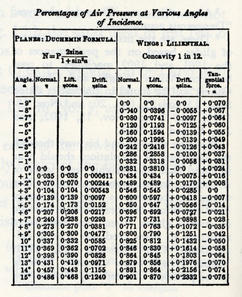
Most likely, the lift and drag data that the Wright brothers used to
design their 1900 and 1901 gliders was this chart from Octave
Chanute' s Progress in Flying
Machines, published in 1894. Note that the numbers were for a
single wing shape, the 1/12 camber that Lilienthal had used.
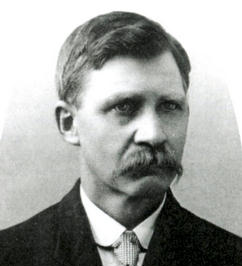
Charlie Taylor in 1901, about the same time he went to work for the
Wright brothers.
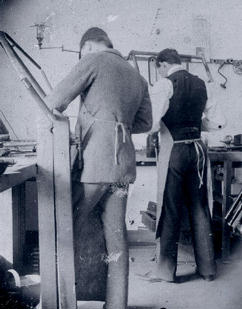
Charlie (left) working in the bicycle shop with Orville (right).
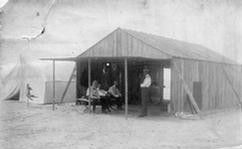
Upon their return to Kitty Hawk in 1901, the Wrights
built a hangar to house their new glider.
They also sank a well by driving a pipe into the sand – note the
pump on the left.
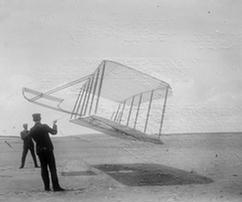
Kiting the 1901 glider.
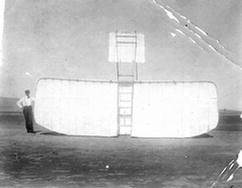
A bottom view of the 1901 glider. Note how large the
wings are in comparison to Orville.
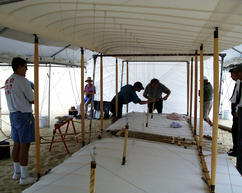
Adjusting the complex rigging that holds the wing shape of our 1901
Wright glider replica during our test flights at the North Carolina
Outerbanks.
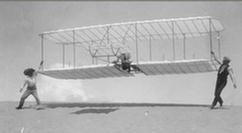
Launching the 1901 glider. Wilbur is in the cockpit,
Dan Tate is on the left and Edward Huffaker on the right.
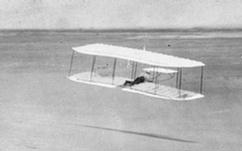
The 1901 glider in flight after the wings had been
re-rigged.
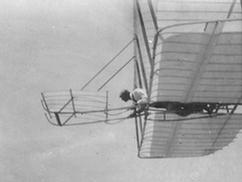
A close-up of Wilbur piloting the 1901 glider.
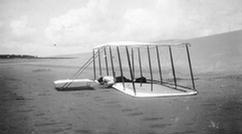
The 1901 Glider after a hard landing.
|